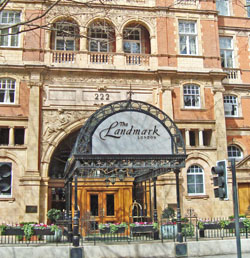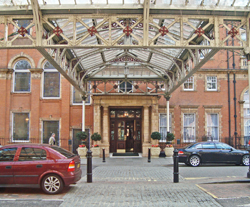Hospital for Officers
Military
In 1916 the War Office took possession of the 700-bedded Great Central Hotel in Marylebone for use as a military hospital for wounded and sick officers. The War Office named it the Prince of Wales Hospital.
By 1917 it had 750 beds, of which 300 were for medical and 170 for surgical cases.
It does not seem to have been a happy place. There were concerns about the paucity of food and about the 'German' hotel manager being an enemy alien (he was Swiss). As it was a military hospital, military conditions applied. Patients were not allowed to leave the Hospital before 1 p.m. nor attend theatre matinees without permission. Those considered fit enough by the Commandant, Col. Charles Edward Harrison, were required to attend military lectures for two hours on alternate mornings or afternoons.
In April 1918 electric bells were installed in the rooms so that patients could summon help.
At the beginning of November 1918, almost at the end of the war, the Hospital contained 780 patients, who were cared for by 43 nurses, 30 nursing orderlies and 30 members of the local Voluntary Aid Detachment.
Following the outbreak of Spanish flu, complaints were made in Parliament that patients with flu were being nursed in the same rooms as those recovering from wounds, thus causing a serious possibility of the infection spreading.
By July 1919 all patients had been evacuated from the Hospital, and it closed in the autumn of that year, after the stores and equipment had been removed.
Present status (April 2010)
The building became a convalescent hospital for servicemen again during WW2. It later became the headquarters of the British Railways Board (familiarly referred to by railway staff as the 'Kremlin').
The building was completely renovated during the 1980s. Today it is the Landmark Hotel.

The Hotel building on the corner of Marylebone Road and Great Central Street.

The main entrance on the south side along Marylebone Road.

The iron and glass covered way of the northern entrance in Melcombe Place is linked to the porte-cochere of Marylebone station.
(Author unstated) 1916 Hospitals for wounded officers. Lancet 2, 693.
(Author unstated) 1917 List of the various hospitals treating military cases in the United Kingdom. London, H.M.S.O.
http://en.wikipedia.org
http://hansard.millbanksystems.com (1)
http://hansard.millbanksystems.com (2)
http://hansard.millbanksystems.com (3)
http://hansard.millbanksystems.com (4)
http://hansard.millbanksystems.com (5)
http://hansard.millbanksystems.com (6)
http://hansard.millbanksystems.com (7)
http://viewfinder.english-heritage.org.uk (1)
http://viewfinder.english-heritage.org.uk (2)
www.landmarklondon.co.uk
www.lib.utulsa.edu
www.scarletfinders.co.uk
Return to home page